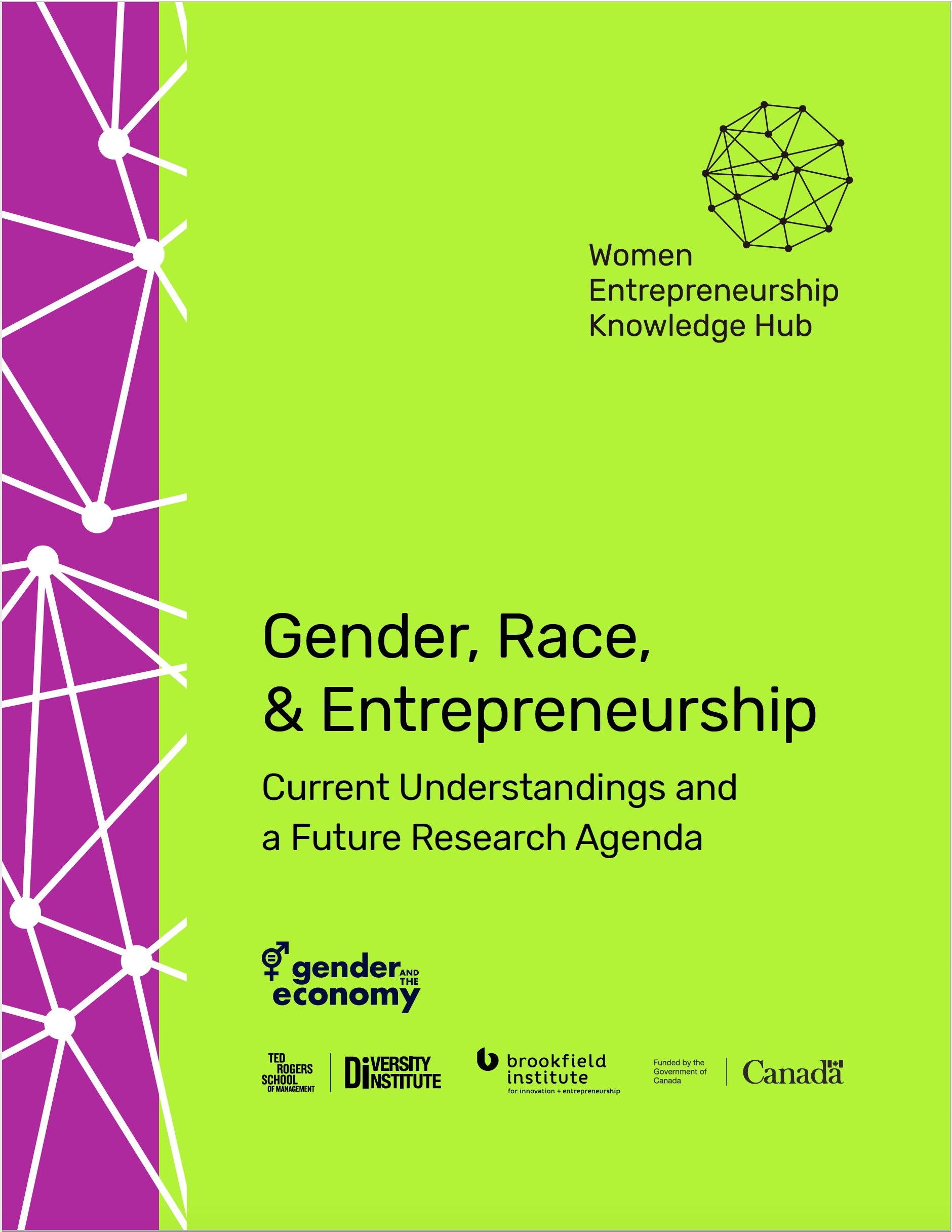Download this research brief (in English/en Français).
This research overview is based on the fascinating conversations we had in our Workshop on Gender, Race and Entrepreneurship, sponsored by the Government of Canada’s Women Entrepreneurship Hub.
Overview
Entrepreneurship is a key path to job creation and economic growth in the modern economy, yet women and minorities remain underrepresented. Research to date has documented some “supply side” factors showing that women and/or minorities are less likely to enter entrepreneurship and some “demand side” factors highlighting the struggle these entrepreneurs face in getting funding and other resources.[1] [2] [3] A 2013 review by Jennings and Brush documents many of these insights.[4] We know less, however, about how the supply side and demand side interact and what kinds of interventions might improve outcomes.
To explore these challenges, the Institute for Gender and the Economy at the University of Toronto’s Rotman School of Management convened a 6-week workshop series in October and November 2020 sponsored by the Government of Canada’s Women Entrepreneurship Knowledge Hub. Organized by Camille Hebert and Sarah Kaplan, the workshop hosted over 150 scholars from around the world who heard cutting edge research from sociology, economics, management and finance researchers, including Asia Bento (Rice), Ruiqing Cao (Harvard), Alexia Delfino (Bocconi), Stefan Dimitriadis (U Toronto), Sabrina Howell (NYU Stern), Song Ma (Yale), Milan Miric (USC Marshall), Tiantian Yang (Wharton), Emmanuel Yimfor (Michigan Ross), and Jonathan Zandberg (Boston College). In the final session, senior scholars Mike Ewens (Caltech), Fiona Murray (MIT Sloan), Zulema Valdez (UC Merced) discussed the future research agenda for gender and race in entrepreneurship. The workshop and discussions underscored a number of debates and controversies in the entrepreneurship literature which are highlighted below along with a roadmap for a future research agenda in gender, race and entrepreneurship. To learn more about the event, including a video summary, click here.
What are work and family conditions that shape entry into entrepreneurship?
When looking at the dearth of women in the entrepreneurial space, people often suggest that it is because women don’t prefer entrepreneurship. However, research is making it increasingly clear that there are other important social and structural factors that shape these choices. A long stream of research has established that motherhood (much more so than fatherhood) leads to career and pay penalties for women, but the effects of motherhood or potential motherhood on entrepreneurship are just starting to be explored. The transition to entrepreneurship can occur during different life stages and at various career trajectories. Understanding life and workplace conditions that women and minority entrepreneurs face is important because these conditions predict the types of businesses created as well as the timing of business creation.
- Diminishing career opportunities at work accelerates entrepreneurship for women. Individuals may consider entrepreneurship as a career option if they find that opportunities at their current jobs are not sufficient. Reduced career opportunities at work—especially associated with the penalties that women pay for motherhood such as lower pay, fewer paths to promotion, and poor access to family-friendly work policies—increases the likelihood that women will become entrepreneurs.[5]
- Entrepreneurship may not always be an ideal career outcome for women. For women, the need for flexible time due to work-family conflict can predict entry into self-employment, as self-employment often allows for more flexible work schedules. This highlights the fact that entrepreneurship maybe not always be an ideal outcome for women who may be forced into it because more stable employment is not available. Scholars have called this type of entrepreneurship “Plan B” entrepreneurship and have shown that these constraints often lead to self-employment or small, low-growth businesses [6].
- The start of family life for women may constrain entrepreneurship. Women who choose to exploit an entrepreneurial idea may also defer family decisions until after they have started their businesses. New research shows that better access to reproductive health care (e.g., access to abortion clinics, emergency contraception, or to fertility programs such as egg freezing) increases women’s entrepreneurship as well as their ability to raise capital and prevent bankruptcy.[7] [8] [9] This evidence suggests that if women do not have access to reproductive healthcare, this may limit their entry into high-growth entrepreneurship which is seen as highly demanding.
- We may need new approaches to attracting women to entrepreneurship. Recent research shows that men are more likely to be attracted to jobs that demonstrate a potential for high returns to effort (a challenging environment). For women, a higher perceived share of men in a field (which is certainly the case of entrepreneurship) discourages women from entering, with only the most talented applying.[10] This may mean, in the case of entrepreneurship, that too many men are entering at lower quality while not enough women are entering.
Obstacles in turning entrepreneurial ideas into businesses
Even if individuals have entrepreneurial ideas, turning those ideas into businesses require being evaluated favourably key stakeholders in in entrepreneurial financing and in commercialization stages. What are the mechanisms that explain how these stakeholders may differentially evaluate entrepreneurial ideas from women and minorities?
- Networking with venture capital firms may be more difficult for women. Entrepreneurs may experience difficulties in funding depending on their gender or minority status. Because entrepreneurial ideas carry high uncertainty, potential funders including venture capital firms (VCs) rely on personal introductions and referrals for deal sourcing. Yet, a study showed that exposure to networking opportunities benefited male entrepreneurs, but not women.[11] It appears that women may not access these networking opportunities because they felt that the VCs wouldn’t have the background to understand their business, they feared discrimination, or they held themselves to a too-high standard. Thus, designers of innovation incubators, accelerators or pitch competitions should work to reduce these networking-related frictions for women entrepreneurs.
- Startup pitches are evaluated differently based on gender. In addition to barriers to networking with potential funders, the content of the pitches by female entrepreneurs may be interpreted differently from pitches by male entrepreneurs. Building on research showing that pitches for the identical business by men received more recommendations for funding than pitches by women[12] [13], recent research using video analysis shows that women entrepreneurs, relative to male entrepreneurs, are judged more on delivery than on informational content.[14] This puts women in a double bind because pitches mainly chosen based on delivery, rather than content, were associated with lower ex-post performance, suggesting that investors have biased beliefs about gender. While it may be tempting to tell women that they need to learn to be more persuasive, this may not be particularly helpful. Instead, motivating evaluators to focus more on the content ultimately facilitates financing of the best entrepreneurial ideas. Rather than “fixing the women,” these results point to solutions that “fix the system” (the demand side of entrepreneurship).
- During the commercialization stage, the paucity of female product evaluators can hurt female entrepreneurs. Beta testers on online platforms are often used to evaluate products in the commercialization stage. However, because these testers are mostly men, they may not accurately assess the products targeting women, hurting the likelihood of women-targeted products developed by female entrepreneurs. As a result, products that are eventually commercialized might not reflect preferences of the entire group of consumers which impacts which products survive and grow.[15] Therefore, paying attention to the composition of early users, such as beta testers, can improve the reach and effectiveness of innovations and, conversely, biased early testing can reduce innovation impact.
The role of institutions
There are also important roles played by the authorities that govern, monitor and support well-functioning entrepreneurial activities. Because these institutions can confer legitimacy to entrepreneurial entities and provide capital that accelerate the creation of businesses, it is important to examine whether different minority groups benefit equally from roles played by these institutions.
- Institutions can help to boost legitimacy of businesses founded by women. Because women’s contributions in the economy, especially in entrepreneurship, tend to be devalued, they often need to access sources that support their legitimacy. This challenge is particularly acute in settings where the power of formal institutions is weak, such as in developing countries or in any other context that puts a heavy weight on personal relationships and trust. Globally, 78% of all entrepreneurship occurs in the informal economy. In a study of entrepreneurs in Togo, where the majority of entrepreneurs operate in the informal economy, the formal registration of businesses benefited women entrepreneurs more than men entrepreneurs.[16] Similar effects for other kinds of adjudicating institutions were also identified in Zambia.[17] If entrepreneurial performance depends heavily on building relationships, women entrepreneurs may face more hurdles as they are subject to traditional gender beliefs about them. Formal registration and other legitimization mechanisms can compensate for these disadvantages.
- Institutional resources meant to boost entrepreneurship may unintendedly reinforce racial divides. Government interventions are often intended to drive financial resources into communities which could spur entrepreneurial activity. A study that explored federal recovery programs after natural disasters, showed that capital from recovery assistance programs was only associated with increases in self-employment for whites, but not other racial groups.[18] These effects were attributed to social vulnerabilities tied to racial marginalization and hoarded opportunities tied to white privilege. These results suggest that institutions could reproduce, rather than alleviate, racial inequalities, particularly in the wake of crisis.
- Institutions can improve entrepreneurial performance by monitoring entrepreneurial financing. Because funding is difficult to access, particularly for women and minority entrepreneurs, brokers and finders can be helpful intermediaries. Indeed, new research shows that women and minority entrepreneurs do access these sorts of resources. However, brokered offerings—because they mainly aggregate funds from retail investors—don’t perform as well because they don’t bring the same advantages of advice and networks that come with VC funding. For example, from a sample of startup offerings in the US from 2010-2019, brokers intermediated 15% of startup offerings, but 20% of these brokers were unregistered by SEC (Securities and Exchange Commission). The performance gap between registered and unregistered brokers was wider in fiduciary states (where brokers are subject to higher standards) and when unregistered brokers have a history of misconduct.[19] Thus, while these intermediaries can mitigate the challenges that underrepresented entrepreneurs face in accessing financing, without better regulations, they could actually exacerbate the entrepreneurship divide.
The path forward and future research agenda
The emerging research presented at this workshop series opens up exciting new lines of inquiry and suggests a new research agenda for studies of gender, race and entrepreneurship. These possibilities explore both the supply-side questions about who enters entrepreneurship and the demand-side questions about what factors are keeping women and minorities out or inhibiting their success. In our rich discussions in each of the workshop sessions, as well as in the final panel with senior scholars reflecting on the field, we developed a fruitful list of questions and opportunities.
- Why entrepreneurship? The research shared in this workshop series highlighted that entrepreneurship is not often people’s first choice. Some entrepreneurs or self-employed people have simply been excluded from the paid workforce. Often employment is better for personal outcomes because it could come with benefits, sick leave and a steady source of income. Entrepreneurs are sometimes racial minorities who are excluded from the regular workforce or women who can’t make a corporate job work with her responsibilities at home given the gendered division of labor in unpaid care work. This research cautions us not to glorify entrepreneurship as an outcome but understand its costs and benefits, assessing not only how to get people into entrepreneurship but whether that is even the best outcome.
- An intersectional gender lens on entrepreneurship. Neither those seeking capital nor those providing capital are representative of society in terms of gender and race. Entrepreneurship is not just an economic activity but also a cultural phenomenon that has historically been fundamentally masculinist and white and where attempts have been made to be more inclusive, they have often glorified a certain type of female entrepreneur that leverages the intersection of white, heteronormative power.[20] Thus, unsurprisingly, the discussions in this workshop made clear that we need to consider gender, race and their intersections in studying and implementing policies to support entrepreneurship. Most research on women in entrepreneurship does not consider race. There is less research on race and entrepreneurship, and what exists often neglects important gender distinctions.
- Not all entrepreneurship is created equal. These discussions also highlighted the fact that not all entrepreneurship is the same. Research would do well to distinguish between self-employment, small and medium enterprises (SMEs) without growth aspirations, and high-tech, high-growth entrepreneurship. The reasons for entering entrepreneurship and the roadblocks to success in each of these different categories is different. Each plays a valuable role in society. We tend to glorify high-tech entrepreneurship, but SMEs are the source of more employment. For example, more than 90% of all workers in the private sector in Canada are employed in SMEs. Similarly, entrepreneurship may not operate in the same ways in different regions around the world and the role of women may differ in these diverse contexts. Researchers and policy makers would do well to distinguish between the dynamics associated with each without devaluing certain types of entrepreneurial efforts relative to others.
- Understanding racial and ethnic minority entrepreneurs. Although we are beginning to understand the unique challenges that women entrepreneurs face, we know relatively less about precursors of entrepreneurship for racial and ethnic minorities. We know even less about how gender intersects with race and ethnicity. Empirically, this is related to small numbers of businesses created by racial and ethnic minorities in most study samples. Conceptually, we need to be conscious about using pan ethnic categories that may blur the boundaries of different ethnic groups in it. For example, within the population of people from Latin-American descent, there may be differences in initial conditions that predict the creation of businesses depending on ethnic groups (e.g., Cuban origin versus Mexican origin). The monolithic treatment of Latinx peoples may compress distinct ethnic subgroups, which masks different economic conditions and identities among these groups.[21] The same argument could be made for different groups within Asian entrepreneurs (e.g., Korean-American business-owners versus Japanese-American owners) or Black entrepreneurs who may be African-American or recent immigrants from Africa, the Caribbean or elsewhere. Therefore, to understand different entrepreneurship trajectories by race, we need conceptual toolkits to capture these differences as well as data that allows for comparison across different ethnic groups within the same pan ethnic category.
- Family members as hidden funders and entrepreneurs. Securing entrepreneurial capital has become easier over time (for example, through the National Securities Markets Improvement Act of 1996)[22], yet we continue to witness underrepresentation of women and minority entrepreneurs. A possible answer to this question can come from understanding family and workplace conditions of women and minority entrepreneurs. Entrepreneurship is often a family endeavour, and by primarily examining entrepreneurship as an individual activity, we are missing out important factors related to funding as well as founding decisions. Further, entrepreneurs frequently rely on family for securing startup funding and sustaining business. For example, having a partner with a stable job allows entrepreneurs to persist in their business. This highlights the importance of understanding family conditions especially during the early stages of entrepreneurship. Once the business is created, an entrepreneurs’ spouses may be “shadow entrepreneurs,” playing as significant role as the founder but with less recognition. For example, depending on cultural norms that entrepreneurs are exposed to, a wife’s labor can be perceived as “family labor” readily available to entrepreneur husbands, whereas men’s labor is perceived as their own.[23] Future research should examine the role of these hidden entrepreneurs as a critical part of the entrepreneurial funding landscape and workforce.
- Industry dynamics shaping entrepreneurial dynamics. There may be systematic variations in the gender gap in entrepreneurship by sector, but we are only beginning to observe these patterns and underlying mechanisms. For example, the gender gap in entrepreneurship in digital industries is greater than other industries. This is surprising given that digitization actually lowers the costs of launching businesses (for example, everyone can access Amazon Web Services for their data infrastructure rather than building it themselves) which should erode funding frictions that would be a source of the gender gap in entrepreneurship.[24] If funding isn’t the barrier, then what other structural characteristics in the high-tech industry would predict the lower likelihood of entrepreneurship for women, compared to other industries? It is also possible that the gender gap in entrepreneurship by industries is related to gendered distribution of workers in certain industries in the first place (male-dominated versus female-dominated sectors).[25] Large-scale field experiments would help us to understand conditions that may facilitate men’s entry into jobs dominated by women and vice versa.
- Activating networks and referrals. The research shared in this workshop series highlighted the importance of networks for entrepreneurs to achieve success. These networks, properly mobilized, can provide access to funding, advice and other resources. Yet, the studies suggest that it is not enough to expose women and underrepresented minorities to potential networks. We also are unclear if structured interventions to create networks such as accelerator programs actually help in this regard. In addition, disentangling the effect of networking in explaining business outcomes remains challenging, empirically.[26] Connecting networks to outcomes is difficult because it is a two-sided matching problem: you need to understand how and why each matches with the other. Future research would seek to understand the underlying mechanisms that explain the benefits of networking and mentorship and determine what interventions would work to activate useful networks for underrepresented groups.
- Reducing gatekeeper biases. The role of gatekeepers, such as VCs, are critical in early stages of startups. By studying these gatekeepers over time, we can sort out the sources of bias and appropriate interventions. For example, central to statistical discrimination theory is that when beliefs turn out to be inaccurate, actors can update their beliefs. Will we see gatekeepers update their beliefs on businesses led by women and minorities? What are ways to disentangle statistical discrimination versus taste-base discrimination against women and minority entrepreneurs? To answer these questions, researchers should leverage study designs that track behaviours of gatekeepers over multiple periods.[27] In the short run, it may be necessary to provide women and minority entrepreneurs with other supports that will increase their legitimacy as a compensatory mechanism that may offset biases.[28] For example, in Togo, this was formal business registration. In the Silicon Valley, this might be affiliation with a top VC or endorsements from recognized leaders. Such signals may help women and minority entrepreneurs overcome gatekeepers’ uncertainties around their quality and potential. Research might ask whether social capital can be transferred, as we are seeing African American stars in music, movies and sports entering into entrepreneurship or into entrepreneurial financing.
In sum, the emerging research on gender and race is shedding new light on the complex dynamics of assuring equal opportunities in the entrepreneurial space. Many of the insights direct our attention away from seeing this as a “supply side” problem in which not enough women and minorities enter entrepreneurship and towards seeing how “demand side” factors such as systemic racism, biased evaluations, and family dynamics disguise limits and impede success. We also see an emerging set of solutions—such as interventions with gatekeepers, creating legitimacy mechanisms and reconfiguring institutional supports—that should lead to greater equity in our economy.
__________________________
RESEARCH OVERVIEW PREPARED BY:
Hyeun Lee and Sarah Kaplan, Institute for Gender and the Economy at the University of Toronto’s Rotman School of Management.
The preparation of this research overview was supported by the Government of Canada’s Women Entrepreneurship Knowledge Hub (WEKH).
CITE AS:
Lee, Hyeun. and Kaplan, S. (2021). “Debates and controversies in understanding gender, race and entrepreneurship,” Institute for Gender and the Economy, https://www.gendereconomy.org/debates-and-controversies-in-understanding-gender-race-and-entrepreneurship/.
References
[1] Kanze, D., Huang, L., Conley, M. A., & Higgins, E. T. 2018. We Ask Men to Win and Women Not to Lose: Closing the Gender Gap in Startup Funding. Academy of Management Journal, 61(2): 586–614.
[2] Ewens, M., & Townsend, R. R. 2020. Are early-stage investors biased against women? Journal of Financial Economics, 135(3): 653-677.
[3] Hebert, C. 2020. Gender stereotypes and entrepreneur financing. Working Paper available on SSRN: https://papers.ssrn.com/sol3/papers.cfm?abstract_id=3318245
[4] Jennings, J, & Brush, Candida G. Research on Women Entrepreneurs: Challenges to (and from) the Broader Entrepreneurship Literature. Academy of Management Annals, 7(1): 663-715.
[5] Yang, T., Kacperczyk, A., & Naldi, L. 2020. Career Antecedents of Female Entrepreneurship. Working Paper.
[6] Thébaud, Sarah. 2015. Business as Plan B: Institutional Foundations of Gender Inequality in Entrepreneurship across 24 Industrialized Countries. Administrative Science Quarterly, 60(4): 671-711.
[7] Zandberg, J. (Forthcoming). Family Comes First: Reproductive Health and the Gender Gap in Entrepreneurship. Journal of Financial Economics.
[8] Zandberg, J. 2020. Reproductive Rights and Women’s Access to Capital. Working Paper. https://papers.ssrn.com/abstract=3727553.
[9] Core, Fabrizio. (2020). Maternity Risk and the Gender Gap in Entrepreneurship. Working paper available on SSRN: https://papers.ssrn.com/sol3/papers.cfm?abstract_id=3539508
[10] Delfino, Alexia. 2020. Breaking Gender Barriers: Bringing Men into the Pick-Collar Jobs of the Future. Working Paper. https://drive.google.com/file/d/1T2KKmwIaqTZ9HiuAExq2vItss75R4_7X/view?usp=sharing
[11] Howell, S. T., & Nanda, R. 2019. Networking Frictions in Venture Capital, and the Gender Gap in Entrepreneurship. Working Paper. https://papers.ssrn.com/abstract=3484700.
[12] Brooks AW, Huang L, Kearney SW, Murray FE. 2014. Investors prefer entrepreneurial ventures pitched by attractive men. Proceedings of the National Academy of Sciences, 111(12): 4427–4431.
[13] Op cit. Hebert, C. 2020.
[14] Hu, A., & Ma, S. 2020. Human Interactions and Financial Investment: A Video-Based Approach. Working paper available on SSRN: https://doi.org/10.2139/ssrn.3583898.
[15] Cao, R., Koning, R., & Nanda, R. 2020. Biased Sampling of Early Users and the Direction of Startup Innovation. Working Paper available on SSRN. https://doi.org/10.2139/ssrn.3736119.
[16] Dimitriadis, S. 2020. Gender, formal registration, and entrepreneurial performance. Working Paper.
[17] Ashraf, Nava, Delfino, Alexia, & Glaeser, Edward L. Rule of Law and Female Entrepreneurship, NBER working paper, available at https://www.nber.org/papers/w26366
[18] Bento, A., & Elliot, J. 2020. The Racially Unequal Impacts of Disasters and Federal Recovery Assistance on Local Self Employment Rates. Working Paper.
[19] Yimfor, E. 2020. Brokered Startup Financing. Working Paper available on SSRN: https://papers.ssrn.com/sol3/papers.cfm?abstract_id=3511164.
[20] Heizmann, H., & Liu, Helena. (forthcoming) “Bloody Wonder Woman!”: Identity performances of elite women entrepreneurs on Instagram. Human Relations.
[21] Valdez, Z. 2011. Political Participation Among Latinos in the United States: The Effect of Group Identity and Consciousness. Social Science Quarterly, 92(2): 466–482.
[22] Ewens, M., & Farre-Mensa, J. 2020. The Deregulation of the Private Equity Markets and the Decline in IPOs. The Review of Financial Studies, 33(12): 5463–5509.
[23] Valdez, Z. 2016. Intersectionality, the household economy, and ethnic entrepreneurship. Ethnic and Racial Studies, 39(9): 1618–1636.
[24] Yin, P., & Miric, M. 2020. Population-level Evidence of the Gender Gap in Technology Entrepreneurship. Working Paper.
[25] Op cit. Delfino, A. 2020.
[26] Chatterji, A., Delecourt, S., Hasan, S., & Koning, R. 2019. When Does Advice Impact Startup Performance? Strategic Management Journal, 40(3): 331–356.
[27] Rubineau, B., & Kang, Y. 2012. Bias in White: A Longitudinal Natural Experiment Measuring Changes in Discrimination. Management Science, 58(4): 660-677.
[28] Castilla, E. J., & Rissing, B. A. 2019. Best in Class: The Returns on Application Endorsements in Higher Education. Administrative Science Quarterly, 64(1): 230–270.
Research summary prepared by
Hyeun Lee and Sarah Kaplan
Published
January, 2021









